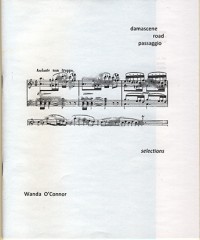 damascene road passaggio, selections
damascene road passaggio, selections
Chapbook, Wanda O’Connor, above/ground press, abovegroundpress.blogspot.com, $4
Not many chapbooks require an explanatory essay (“subtext/pretext,” the author calls it), but the one that Wanda O’Connor includes as an afterword to damascene road passaggio is definitely warranted, even if it’s somewhat obtuse.
In her afterword, O’Connor describes this fragmented long poem as “a sequence of asides and sides that take as their companions letters addressed to no one… This project takes up Kafka’s intercourse with ghosts” (an “intercourse” Kafka once likened writing letters to). One would assume there’s also something Opera-related happening here — passaggio is a term used to describe pitch ranges in classical singing. Another handy definition: a damascene road — better known as a road to Damascus experience — is a religious conversion, or a revelation about one’s self.
A reasonable amount of research is clearly recommended before tackling this chapbook, though the above falls short of providing anything near complete comprehension. O’Connor’s writing isn’t necessarily highbrow — most of these words, lines and stanzas are completely graspable. What’s challenging is attempting to decipher how the fragments of this poem are all related, if they even are. O’Connor does call this “asides and sides,” so it’s probably best to read these verses without an expectation of interconnectedness.
The text in damascene road passaggio echoes that fragmentation. Words and stanzas are scattered to the left, right and centre, and handwritten notes mingle with phrases, full sentences and typed correspondence. In spite of this fractured presentation, O’Connor’s verse is surprisingly fluid, which suggests that full understanding will come, eventually (after more research). Let it be said, at least, that this is poetry that teaches. (Scott Bryson)
